Create an Inclusive Environment
In celebration of Pride Month, take some time to ensure your team understands the importance of using correct personal gender pronouns. Everyone, not just transgender or nonbinary individuals, wants to be referred to by the correct pronouns. Understanding that there is a wide range of gender identities and expressions can foster a more inclusive work environment.
Leaders and managers who encounter various gender identities in their workplace can create opportunities for team development and improved communication by respecting their employees’ preferred pronouns.
What Are Personal Gender Pronouns?
Personal gender pronouns (or PGPs) are the pronouns that people ask others to use in reference to themselves, according to Harvard Office for Equity, Diversity, Inclusion & Belonging. The most common gender pronouns are she/her/hers, he/him/his, and the gender-neutral pronouns, they/them/theirs. Other gender-neutral pronouns include ey/em/eirs and ze/zir/zirs. Here is a link to a more complete, although not exhaustive, list of the more commonly used gender pronouns.
If you are unfamiliar with a person’s pronouns, don’t hesitate to ask them. There’s no harm in demonstrating regard for someone’s identity.
Be Respectful
Using the correct pronouns of your colleagues shows them respect, which helps cultivate an inclusive environment. Not only do inclusive environments reduce stress in the workplace, but they also maximize collaboration and increase employee satisfaction.
If you mistakenly misgender your teammate, simply apologize and correct your error. If someone habitually misgenders a co-worker, it can be viewed as discriminatory. Discrimination based on sex, including sexual orientation and sexual identity, is illegal.
Lead By Example
Build an environment of inclusivity to help all of your employees feel seen and respected. Including your pronouns in your email signature and when you introduce yourself conveys a sense of alliance. Keep in mind that revealing one's pronouns may cause anxiety for some LGBTQ+ people, so don't force your employees to do so. You can also incorporate neutral language when addressing your team.
For example, instead of "Thanks, guys," you can say "Thanks, everyone."
Ignoring employees who wilfully use incorrect pronouns can lead to workplace anxiety and exclusion. Respectful behavior, including proper pronoun usage, should be a part of employee policies, with workplace culture reflecting those policies.
Do’s & Don’ts
- Do say your pronouns when introducing yourself.
- Don’t ignore mistakenly using an incorrect pronoun.
- Do incorporate neutral language when addressing the team.
- Don’t assume a person’s pronouns based on the way they look.
- Do respect your team members’ privacy and journey.
Cura HR strives to foster a diverse and inclusive workplace. We believe diversity comes in many different forms—from who we are and what we believe to our personal passions and skill sets. We celebrate what makes us unique and are mindful of creating space for every voice in the room. At Cura HR, the pursuit of diversity and inclusiveness is a journey rather than a destination.
If you would like to discuss your HR needs, get in touch with us today, we’d love to learn about your business.
Know How to Offer Constructive Feedback
A great manager knows how to coach their team and provide effective employee feedback on a regular basis. Constructive feedback offers employees solutions and strategies in the areas they need to improve. In fact, a whopping 68% of employees who receive accurate and consistent feedback feel fulfilled in their jobs, according to Zippia.
When given properly, feedback can encourage employees to grow and become more engaged in their role, which leads to greater job satisfaction and better communication between parties. At the end of the day, a productive organization is one filled with people who feel passionate about their jobs and supported by their managers.
Knowing how to offer constructive feedback is a learned skill that will benefit your entire organization. In this blog, we’ll give you tips on making your employee feedback more effective.
Give Feedback Early and Often
Infrequent feedback sessions may increase employees' stress when asked to have one-on-one discussions. In addition, waiting for performance reviews can leave employees to repeat mistakes. Over time, small mistakes can lead to significant problems. Instead, informal, weekly feedback can quickly course-correct and drive employee performance. A more casual work culture can be propagated by including feedback in the everyday work routine.
Does the Delivery Method of Feedback Matter?
Since “The Great Remote-Work Migration of 2020,” different modalities of relaying employee feedback have become necessary. According to a Western Michigan University study, the delivery method does not significantly increase or decrease performance when objective feedback is given. There is, however, a significant effect on performance when comparing people who receive objective feedback to those who receive no feedback.
Although employee performance may be unaffected by the modality of feedback delivery, it can be challenging to convey tone or emotion in text messages and emails. For this reason, consider providing constructive feedback in person, via phone, or via video conversation. On the other hand, positive feedback via email, phone calls, video chat, and in-person are appropriate.
Listen and Be Empathetic
The intention of feedback is to help each team member reach their full potential, which will create a culture of continuous development. This is done by managers who listen, ask questions, are empathetic, and encourage dialogue.
Providing feedback with an accusatory tone can make employees feel as though you aren’t on their side and may shut down a conversation. Managers who offer empathy and an openness to hearing what their team member says about the given situation is far more effective. Listening to others may even help you learn about items to change and areas for improvement.
The Benefits of Properly Executed Feedback
Employees are hungry for feedback from their leaders, managers, and even their peers. They want to gain insights that advance their professional abilities and potential. Properly executed feedback corrects problems, improves productivity, and strengthens relationships between employees and their managers. Leaders should offer direct, solution-based feedback that celebrates their employees’ strengths.
At Cura HR we know that treating employee engagement as a continual effort rather than a one-time event is essential to an engaged workforce. We help businesses cultivate productive employee experiences across stages in the employee lifecycle.
We’d love to hear about your business so we can understand how to identify and implement the opportunities that will level up your team’s talent!
Hiring HR talent with deep experience in all functional areas of HR can be costly and is often unnecessary. Many businesses outsource various HR functions, including compensation, to ensure compliance with state and federal labor laws, minimize liability, and provide knowledgeable and reliable discipline-expertise.
Did you know that according to Gallup, workplace friendships are linked to increased job satisfaction, better job performance, and higher employee retention?
Every year, millions of college students graduate and enter the workforce. Even with unemployment levels at record lows, some graduates are still struggling to find careers in their chosen fields after graduating.
Management serves functions beyond decision-making and bringing expertise to your business. Leading by example, managers set the tone of the workplace for all employees. Despite this, a study done by West Monroe found that 43% of new managers had not received any formal management training.
Creating effective development strategies for leadership at your company is essential for promoting best-in-class management practices. If you’re not sure where to start, the Cura team has effective training suggestions to help you develop your managers so they can optimize their leadership skills!
Soft Skills Training
Soft skills are essential for anyone in a leadership role. Soft skills training allows managers to better connect with employees in order to provide effective feedback, set goals and expectations, and build trusting and productive relationships. A manager with effective soft skills can promote a healthier work environment, which is good for your employees’ mental health.
Soft skills training should focus on:
- Communication skills
- Building trust
- Giving and receiving feedback
- Active listening
- Recognition and engagement
You can promote soft skills development through either online or in-person courses. If you aren’t sure how to go about this, team Cura offers various training programs for managers and employees alike.
Conflict Resolution Techniques
Soft skills create the foundation for managers to be able to effectively handle and ideally, resolve conflict. Situations such as conflicts between employees can create disharmony in the workplace and can escalate quickly if not resolved. Training managers to both mediate conflict and identify when they need assistance from an HR partner to navigate the situation is important.
Take action to prevent conflict before it starts. Outline clear expectations for behavior, and educate both managers and employees on these practices regularly. Ensure company policies and practices are clear on how to address conflict if it does arise, and that they are followed consistently throughout the organization. Clearly outline the procedures for reporting an issue and consider using an anonymous reporting system allowing employees to inform leadership if they are not comfortable sharing with their manager.
Finally, know when to involve HR in workplace conflicts. More serious issues such as harassment, discrimination, and workplace violence should all be handled in partnership with an HR professional. If you are unsure about how to handle an issue, it’s best to consult with an expert.
Performance Evaluation and Feedback Standards
Effective performance reviews are a great way to show employees how well they are doing. Train managers to address performance evaluations in a thoughtful and productive way. Encourage regular and sincere constructive feedback, and celebrate when they are doing well. Conducting performance reviews and providing feedback should be done face to face when possible to build strong relationships and trust.
Also, partner with your team to establish goals and performance expectations for the upcoming review period. Consider what they are doing well, and the steps that can be taken to improve areas where they’re struggling. Don’t forget to offer support and resources to help them reach these goals.
Company and Legal Knowledge Training
Educate managers on all company policies and programs. It’s critical for them to know about everything from the Code of Conduct, to the Attendance Policy and everything in between. It’s important to be familiar with this information to help support, communicate and enforce policies and practices when needed. Additionally, ensure managers know how to deal with violations of company policies and the appropriate steps to take.
Managers should also be familiar with your products and services, company processes, mission, vision, and business model. The greater their knowledge of your organization, the better they can help advise customers and employees.
Finally, ensure that managers are familiar with state and federal employment laws and regulations. While these are generally overseen by HR experts, it’s important for all managers to be aware of regulations such as the Family and Medical Leave Act (FMLA), Fair Labor Standards Act (FLSA), and the Equal Employment Opportunity Commission (EEOC) laws, among others. Awareness of these laws and regulations is especially important because violating them can lead to serious repercussions for your business.
Create a Management Development Program with Cura HR
Manager training is an ever-evolving topic that needs to align with each organization’s unique needs. A new or experienced employee transitioning into management needs guidance and resources to set themselves and your company up for success.
Cura HR helps our clients identify and implement opportunities to level up their talent. We are certified in the most widely used and reputable people assessment tools, offer extensive manager and employee training, and facilitate effective team-building and development programs. We’d love to learn about your business and how we can help you to develop your team!
Hiring top talent is something every business strives for. After all, experienced and dedicated employees are always excellent to have on your team. As people gain experience, they develop and deepen their skills and competencies. Despite this, many older employees state that they face discrimination in their workplace due to their age. A survey done by the American Association of Retired Persons (AARP) found that 61% of respondents had experienced or witnessed discrimination based on age in their workplace.
This number is especially concerning since the workforce is getting older and working longer in their careers. This means that hiring and keeping experienced talent is more important than ever. Making sure that your workplace is accepting of people of all ages will ensure that you keep older employees satisfied with working at your company. If you’re not sure how to foster an age-inclusive company culture, here are a few suggestions to help.
Ingenuity is the name of the game at Outrider–the pioneer in autonomous freight yard operations for logistics hubs. The only software and development company exclusively focused on automating all aspects of yard operations, Outrider eliminates manual tasks that are hazardous and repetitive while driving efficiency, safety and sustainability.
At Outrider ingenuity doesn’t stop at the yard. The company is committed to on-going progress and growth throughout all facets of the business. This commitment starts with its people. That’s why Outrider teamed up with Cura as its HR consulting partner—not out of necessity, but a proactive desire to continually cultivate a thriving workforce and vibrant work culture.
Projects accomplished
- Job architecture & compensation structure
- Company policies & programs
- Team & manager training
- People-first best practices


Outrider Vitals
- Headquarters: Golden, Colorado
- Team Members: 125+
- Website: www.outrider.ai
- Mission: To drive the rapid adoption of sustainable freight transportation by deploying zero-emission systems.
Embracing a Culture of Continuous Feedback
One of Outrider’s primary goals in partnering with Cura was to upgrade its internal performance management approach. Outrider leadership saw this as an opportunity to lay the tracks for future company advancement and success. Outrider engaged Cura for its People Operations and performance management expertise to assist in developing the right strategy for their business.
- Performance Management is the strategy organizations use to manage, measure, and improve employee performance.
- Continuous Feedback is the practice of regularly exchanging productive feedback between managers and employees as well as peer to peer.


Feedback for Thought
After a thorough internal assessment, Cura identified continuous feedback as a key opportunity area for Outrider to create a performance management process that would deliver high value to its employees and business. Cura’s role was to equip Outrider with the tools needed to build a culture open to proactively giving and seeking feedback.
A recent Gallup survey found that only 26% of employees strongly agree that the feedback they get actually improves their work.

Giving and Receiving Feedback Well
To support the Outrider team in learning how to give and receive feedback, Cura trained their people managers on this concept using a 4-part formula for giving continuous feedback and best practices for effective management.
Continuous Feedback: 4-Part Formula
1 – The Micro Yes
- Ask them if it’s acceptable to provide feedback
- Pace the conversation
- Create buy-in
2 – Data Point
- Share specifics about what you saw or heard
- Remove any blur words (not-specific, may be perceived different than you mean)
- Be detailed and precise – clearly address what needs to increase or diminish
Important for positive feedback too – call out behaviors that need to be repeated
3 – Show Impact
- Provide information on how the data point(s) impacted you, their peers, the team, the customer, etc.
- Give a sense of purpose
- Connect the meaning and logic of the data points
4 – End on a Question
- Gain buy-in by closing out feedback with a question
- Create commitment not compliance
- Focus on problem-solving conversations
- Ask for feedback regularly
Best Practices for People Managers
Cura shared the 4-Part Continuous Feedback Model to enable Outrider’s people managers to be as effective as possible when sharing feedback with their teams.
Key Practices
- Conduct regular 1:1’s
- Acknowledge and recognize your team
- Consider individual work preferences and appreciation languages
- Create growth and professional development plans
- Adopt a growth mindset
The Impact
“Cura HR is fantastic. As soon as we engaged with them, they worked with us to establish a process first to review our existing HR functions, policies and procedures and establish new services to help our growing organization.”
-Alisande Rozynko, VP, General Counsel, Outrider Technologies
See how Cura can advance your organizational growth.
Contact Us







